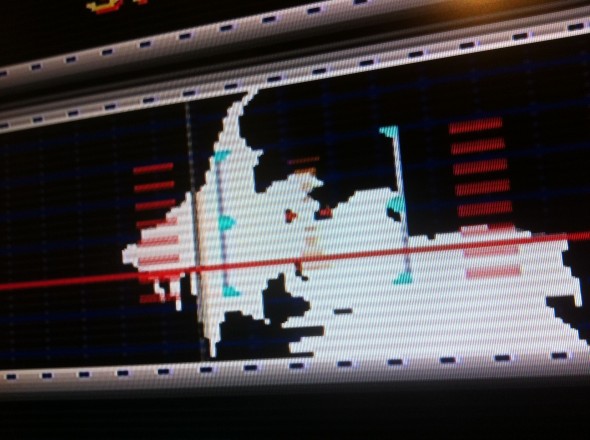
Scanlines. If you hear someone talking about scanlines when discussing video games, you know they’re a dork. I talk about scanlines a lot. Mostly with @damienmcferran and @michaelheald.
What’s the deal then? Well, when we played video games on CRT televisions, there would be faint horizontal lines between the rows of pixels. Kinda didn’t notice back in the day, but when you play an old Mega Drive through a modern HDTV, you will instantly see something is missing.
Modern TVs have built in picture scalers, so a 320×240 picture gets blown up to fit your gloriously large display. You’ll notice the pixels look big and slightly smudgy, edges bleed and the picture just looks a little… smoothed. All arcade games used to have scanlines. I swear a scanline generator/emphasiser was built into the Hanatrex monitors! Adding scanlines makes an arcade game feel even more authentic. I still play all my retro games on a 14″ Sony CRT portable TV because of this effect.
However, all is not lost. If you only have a HD TV, and let’s be honest, very soon this is all people will have, then there is help at hand. A fairly clever German called Jochum over at arcadeforge.de has been making bits of circuitry that will allow you to hook up your old SCART devices to a HD TV and get those beautiful old scanlines back.
It started off with the SLG3000, which took a VGA input, added the scanlines (adjustable too, so you could have them heavy or light) to a VGA output. This looks utterly ace on a Dreamcast with an old Dell 3:4 ratio PC monitor.
But what about consoles that don’t output VGA? Next up came a Sync Strike that basically takes an RGB SCART signal and convert it to a CSYNC composite signal, thus enabling retro gear to run on new teles. However, this does depend on what resolutions your HD TV accepts. My Samsung won’t take anything below a 640×480 resolution, which made me panic at first as things weren’t working!
So… we need another bit of circuitry. A video scaler. Video scalers have been available in Japan and to video enthusiasts for a while, but clock in at around £300. Devices like the XRGB 2 Plus cost the earth but produce great results. Recently, there’s been a growing market for cheap scaler boards from Hong Kong. They feature a multitude of inputs, some basic onscreen displays to adjust settings (including language!) and geometry, but are bare. Jochum started casing them in the same clear acrylic plastic housing that his SLG3000 and Sync Strike come in, and selling them on.
Ultimately, we have three separate doohickeys, two VGA leads and a 5v power supply to get scanlines.
Then Jochum released an SLG SCART box. This simply takes a SCART input, adds scanlines and spits out SCART. Much simpler, one box and a 5v power supply required.
Why would you go through the rigmarole of the first solution if you can do it in one box. Well, the one box came after all the other bits!
But is there more to it than that? Yes, take a look…
Plain jane. Multi-Mega RGB SCART > Samsung 38″ HD TV. Smudgy image. Lego block sized pixels and varying colours across areas of the same colour. What you don’t see from the stills is the way the image “wiggles”. Will try and get video at a later date.
SCART – Sync Strike – Scaler – VGA input



Here you can see Thunder Force III played on a Multi-Mega via RGB SCART Sync Strike > VGA/CGA Scaler > VGA input. The picture is clearer than using the HD TVs scaler. But still you can see the pixels look chunky and the colours tend to smudge into each other. In the last picture, the white edges still loose their sharpness a bit, but generally this £50 scaler is better than the built in TV scaler.
SCART – SLG SCART – SCART input
Getting better. Multi-Mega RGB SCART > SLG SCART > TV SCART input. The scanlines are quite visible on the Mega Drive, because the image has the scanlines applied to the 320×240 image, then the HD TV is scaling the picture up. However, the introduction of scanlines helps add definition to edges, clean up large areas of colour and add that retro feel. On something like a Saturn hi-res game or Dreamcast, the scanlines should look thinner as they’re applied to a higher res image, then scaled.
SCART – Sync Strike – Scaler – SLG3000 – VGA
Here we have Thunder Force III running through the Sync Strike > VGA/CGA Scaler > SLG3000. The scanlines are thinner, as they applied to the image after it’s scaled up to 640×480, as opposed to applied to the image then letting the TV do the scaling. A lot less distortion, you don’t see much “wiggling” while playing, and the picture just seems so much cleaner… and arcade like!
There are plenty of videos on YouTube about using this set up, and lengthy discussions of building your own Sync Strike on a scaler board over on the shmups forums. The SLG SCART is a great, quick and dirty way to add scanlines to your retro games. If you go the whole hog, you get a lot more control and a better output from the combination of Sync/Scaler/SLG. This can also be used to a range of inputs, including Component and CGA, and can connect to a stand alone PC monitor too.
Which ever you chose, it really does help recreate that retro feel on modern TVs.










